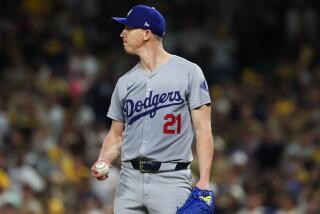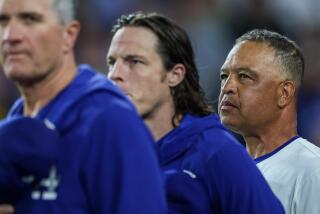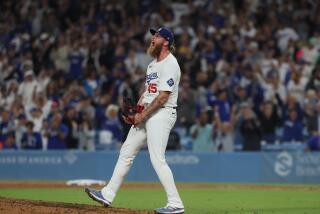Penny Finally Has Good Break
- Share via
VERO BEACH, Fla. — It is his last hitter of the morning, the last thing he will remember, and Brad Penny is playing it safe.
Fastball. Fastball. Fastball. Fastball. Fastball.
It is his last pitch of the morning, and Penny winds up and throws one final ...
Curveball?
A perfectly dipping called Strike 3.
His first strikeout curveball to a live batter in seven months.
“Whoa,” batter David Ross says.
“Thank you!” Penny shouts.
And so on a Tuesday morning with nothing happening, everything happened and now it is finally looking as if the Dodger season will include the arm, and head, of their 250-pound enigma.
A Dodger season that would be lost without him.
“Do you think it looked good?” Penny asks after throwing 46 strong pitches in his second batting practice at near-deserted Holman Stadium. “I think it looked good.”
He’s not the only one.
“If 95 is hurt, I don’t want to see healthy,” infielder Jose Valentin says as he walks away.
Ross, who thought he had seen everything during what has been an awful spring, shakes his head at one more insult.
“Throws me five hard fastballs then that 3-and-2 curve?” he says. “No way anybody is going to touch that.”
Penny, quiet and somber on even the best of these spring days, strokes his long goatee and actually smiles.
“I feel like I’m really cranking it,” he says.
What he thinks matters, because the nerve problems that have sidelined him since late last season have moved from his biceps into his brain.
Surgery wasn’t required. Faith was.
Rest and rehabilitation could fix the biceps. But only Penny could fix the fear.
Typically with this sort of injury, pitchers require months to regain their velocity and sharpness because they are forever worried about a recurrence.
Until Tuesday, Penny had seemed worried.
Spring training crept along while he worried.
Opening day became an afterthought while he worried.
The Dodgers became seriously worried that he was worried.
“It’s like a mental adhesion,” pitching coach Jim Colborn says. “Somewhere, residing in the back of his mind, is a memory of that pain.”
When Penny made his first comeback attempt against the San Diego Padres in late September, six weeks after the initial injury, he was so worried he barely threw anything but fastballs.
The Padres pounded him, the pain returned in the fourth inning, he left the mound for good, and now he wishes he’d never even tried.
“It was stupid,” he says. “But when you’re in a situation like that, you really want to be around for the playoffs, you’ll do everything you can.”
He was so worried, he took the winter off, not throwing until he showed up in Vero Beach last month, and then only gently.
“There’s something in there that’s guarding, protecting the injury,” Colborn says. “Until he really lets go of the ball, it’s going to stay there.”
Tuesday, he really let go of the ball.
His fastball pops loud enough to be heard in the empty parking lot.
The rotation is tight enough that even Eric Gagne, watching from behind the batting cage, notices.
“I never look at velocity, I look at movement, and the ball was really jumping out of his glove,” Gagne says.
And, yes, Penny has started throwing curveballs to hitters, the last step before pitching in a spring game, which could lead to mid-April activation.
“I’m not scared to let the ball go,” Penny says.
The Dodgers only hope.
Penny is more than the only veteran power pitcher in a rotation of sinkerballers and tricksters.
So far, he is the failed sum of Paul Lo Duca and Guillermo Mota, two stars traded for three starts.
So far, he is the reason the Dodgers still don’t have a regular catcher.
So far, some folks still wonder why he wasn’t traded to Arizona for Randy Johnson.
If Penny is strong and pitches to his potential -- he gave up two infield hits in eight shutout innings against the Pittsburgh Pirates in his only sound Dodger start -- he can help put a nice coat of makeup on a suspect offense.
If Penny remains tentative and worried, the rest of the club will battle the nerve problem.
The Dodgers need an ace, and he is the only one within miles.
“There was a time when you had that, ‘Oh, no!’ in the back of your mind, worried that it’s going to happen again,” Penny says. “That time, for me, is gone.”
Then he holds up the right arm upon which so much is riding, flexes the muscle below the giant tattooed cross.
“Just look at this,” he says. “When I had the injury, I didn’t have a muscle. Now I do. That means something.”
He doesn’t have to convince his team. He only has to convince himself.
As Brad Penny laughs the laugh of a healed man, the Dodgers hope he is listening.
Bill Plaschke can be reached at [email protected]. To read previous columns by Plaschke, go to latimes.com/plaschke.
More to Read
Are you a true-blue fan?
Get our Dodgers Dugout newsletter for insights, news and much more.
You may occasionally receive promotional content from the Los Angeles Times.









